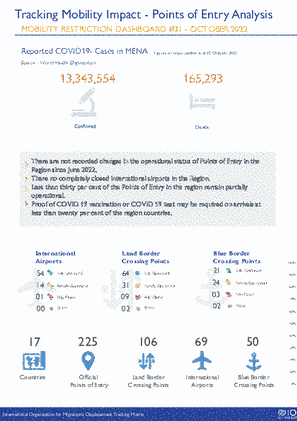-
Countries
-
Data and Analysis
-
Special Focus
-
Crisis Responses

Contact
DTM Europe, DTMMediterranean@iom.int
Language
English
Location
Republic of Moldova
Period Covered
Feb 24 2022
Oct 16 2022
Activity
- Flow Monitoring
- Migrants presence
Between 24 February and 16 October 2022, Ukrainian refugees represented 90 per cent (593,718) of all individuals registered at entry from Ukraine (UKR) to the Republic of Moldova (MDA). The remaining ten per cent (65,886) were Third Country Nationals (TCNs). Similarly, Ukrainian refugees represent 89 per cent (303,660) of all individuals registered leaving the Republic of Moldova towards Romania (ROU) during the reporting period and the remaining 11 per cent (35,893) were TCNs. This report focuses on the observable trends in the data on TCNs who entered the Republic of Moldova from Ukraine and analyzes data concerning their stay or their subsequent movement out of the country.
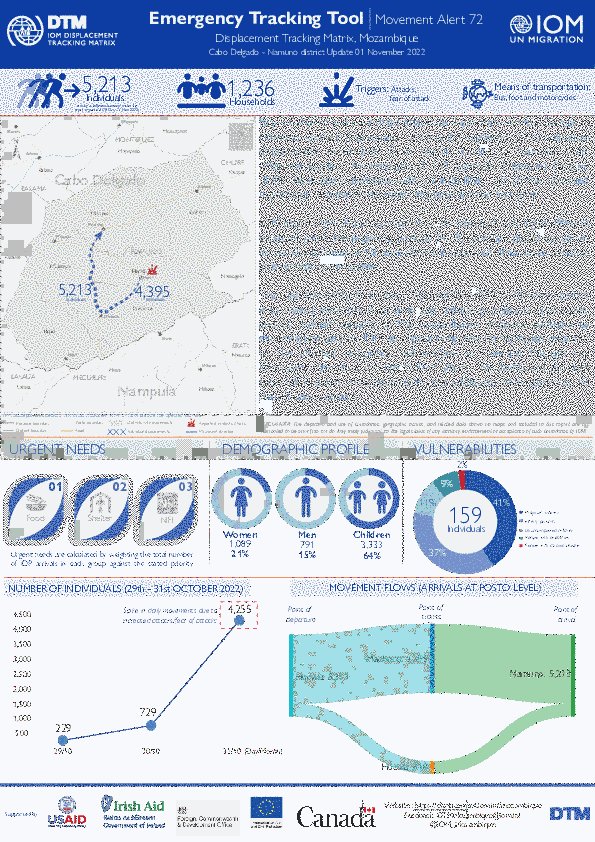
Contact
DTMMozambique@iom.int
Language
English
Location
Mozambique
Period Covered
Oct 29 2022
Oct 31 2022
Activity
- Mobility Tracking
- Event Tracking
Fear of attacks and confirmed attacks by Non-State Armed Groups in Namuno district (Marrumeia community) triggered 5,213 individual displacement movements from Hucula locality to Namuno sede, (Milipone locality). An estimate of 159 Internally Displaced Persons (IDPs) have been identified with vulnerabilities.
All of the recorded movements represent individuals displaced for the first time. IOM teams observed an average of 1,738 individuals arriving at different locations within the reporting period (29 -30 October, please see below for more information). Movements in the region continue to be dynamic among host communities.
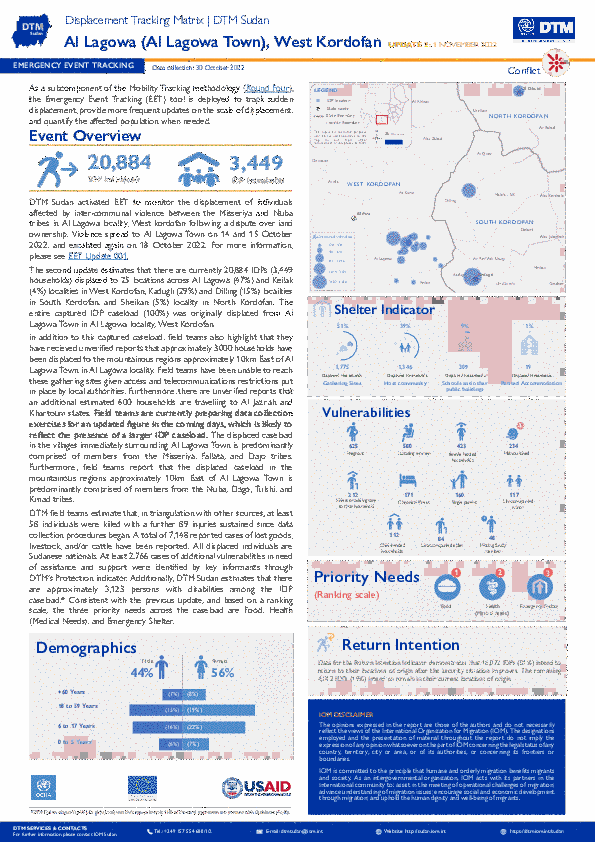
Contact
DTM Sudan; dtmsudan@iom.int
Language
English
Location
Sudan
Snapshot Date
Oct 30 2022
Activity
- Mobility Tracking
- Event Tracking
The DTM Emergency Event Tracking (EET) is deployed to track sudden displacement and population movements, provide more frequent updates on the scale of displacement, and quantify the affected population when needed. As a subcomponent of the new Mobility Tracking methodology in Sudan (Round Four), and activated on a need basis, EET utilises a broad network of key informants to capture best estimates of the affected population presence per location – a useful tool for humanitarian response planning and design.

Contact
DTMMozambique@iom.int
Language
English
Location
Mozambique
Period Covered
Oct 29 2022
Oct 31 2022
Activity
- Mobility Tracking
- Event Tracking
Fear of attacks and confirmed attacks by Non-State Armed Groups in Namuno district (Marrumeia community) triggered 958 individual displacement movements from Hucula locality to Namuno sede, (Milipone locality). An estimate of 100 Internally Displaced Persons (IDPs) have been identified with vulnerabilities. All of the recorded movements represent individuals displaced for the first time.
IOM teams observed an average of 479 individuals arriving at different locations within the reporting period (29 -30 October, please see below for more information). Movements in the region continue to be dynamic among host communities.
This Middle East and North Africa (MENA) report summarizes mobility restrictions at airports, land, and blue border crossing points resulting from the mitigation measures implemented in response to the COVID-19 pandemic.

Contact
DTM Europe, DTMMediterranean@iom.int
Language
English
Location
Kazakhstan
Period Covered
Jun 06 2022
Jul 06 2022
Activity
- Survey
This report highlights key findings from an analysis on the socio-demographic profile, migration journey and intentions, experiences on the workplace and general well-being of labour migrants living and working in three cities of Kazakhstan, namely Almaty, Astana, and Shymkent at the time of the survey. The report also calls attention to their general well-being.
Data on labour migrants in Kazakhstan were collected through the administration of a survey questionnaire in three cities, Almaty, Astana and Shymkent using the tools of the International Organization for Migration (IOM)’s Displacement Tracking Matrix (DTM). A stratified sampling strategy by city and gender was adopted. The fieldwork to survey labour migrants was conducted by a survey company from the 6 June to the 6 July 2022. In total, 2,000 labour migrants participated in the study.
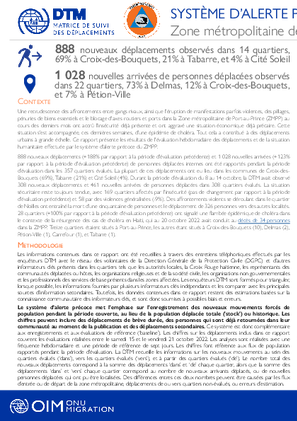
Contact
dtmhaiti@iom.int
Language
English
Location
Haiti
Period Covered
Oct 15 2022
Oct 21 2022
Activity
- Event Tracking
Une recrudescence des affrontements entre gangs rivaux, ainsi que l'éruption de manifestations parfois violentes, des pillages, pénuries de biens essentiels et le blocage d'axes routiers et ports dans la Zone métropolitaine de Port-au-Prince (ZMPP) au cours des derniers mois ont accrû l'insécurité déjà présente et ont aggravé une situation économique déjà précaire. Cette situation s'est accompagnée, ces dernières semaines, d'une épidémie de choléra. Tout cela a contribué à des déplacements urbains à grande échelle. Ce rapport présente les résultats de l'évaluation hebdomadaire des déplacements et de la situation humanitaire effectuée par le système d'alerte précoce du ZMPP.
888 nouveaux déplacements (+188% par rapport à la période d'évaluation précédente) et 1 028 nouvelles arrivées (+123% par rapport à la période d'évaluation précédente) de personnes déplacées internes ont été rapportés pendant la période d’évaluation dans les 357 quartiers évalués. La plupart de ces déplacements ont eu lieu dans les communes de Croix-des-Bouquets (69%), Tabarre (21%) et Cité Soleil (4%). Durant la période d’évaluation du 8 au 14 octobre, la DTM avait observé 308 nouveaux déplacements et 461 nouvelles arrivées de personnes déplacées dans 308 quartiers évalués. La situation sécuritaire reste toujours tendue, avec 169 quartiers affectés par l'insécurité (pas de changement par rapport à la période d'évaluation précédente) et 58 par des violences généralisées (-9%). Des affrontements violents se déroulant dans le quartier de Noilles ont entraîné la mort d'une cinquantaine de personnes et le déplacement de 326 personnes vers des autres localités. 28 quartiers (+100% par rapport à la période d'évaluation précédente) ont signalé une flambée épidémique de choléra dans le contexte de la résurgence des cas de choléra en Haïti, qui au 20 octobre 2022 avait conduit au décès de 34 personnes dans la ZMPP. Treize quartiers étaient situés à Port-au-Prince, les autres étant situés à Croix-des-Bouquets (10), Delmas (2), Pétion-Ville (1), Carrefour (1), et Tabarre (1).

Contact
DTM Mali, DTMMali@iom.int
Language
French
Location
Mali
Period Covered
Sep 01 2022
Sep 30 2022
Activity
- Mobility Tracking
- Baseline Assessment
Dans un contexte marqué par l’insécurité et la fermeture des frontières terrestres et aériennes entre le Mali et les pays de la Communauté économique des Etats de l’Afrique de l’Ouest (CEDEAO), des combats et attaques sporadiques se sont poursuivis dans plusieurs localités du pays occasionnant des déplacements internes de populations civiles dans le Nord et dans le Centre du pays. Le caractère violent des conflits a provoqué d’importants déplacements de populations à l’intérieur du territoire malien et dans les communes frontalières entre le Burkina Faso et le Niger, avec des méthodes de mouvements très complexes à suivre. Des déplacements de courte durée ont continué à être signalés dans différentes régions du pays.
Chaque semaine, de nouvelles personnes déplacées internes (PDI) continuent d’être enregistrées. Ces mouvements ont un impact considérable sur les personnes forcées de fuir leurs foyers et sur les communautés qui les accueillent.
Afin de répondre aux besoins des populations déplacées internes, rapatriées et retournées, la Commission Mouvement de Populations (CMP) recueille et analyse les informations sur les mouvements de populations à l’intérieur du Mali, afin de fournir un état complet des mouvements de populations et à la demande de ses partenaires. Les membres de la Commission sont : la Direction Générale de la Protection Civile (Ministère de la sécurité intérieur), UNHCR, OCHA, PAM, UNICEF, ACTED, NRC, DRC, HI, Solidarités International, CRS, OIM, et DNDS. Plusieurs autres entités participent régulièrement aux rencontres de la Commission.
The Horn of Africa and Yemen is one of the busiest and riskiest migration corridors in the world travelled by hundreds of thousands of migrants, the majority of whom travel in an irregular manner, often relying on smugglers to facilitate movement along the Eastern Route. This regional report provides monthly updates on the complex migratory dynamics through Djibouti, Somalia, Yemen and Ethiopia based on diverse data sources and consultations with key informants in the four countries. Moreover, it provides information on the main protection concerns for migrants along the journey, information on the spill over effects of the conflict in Northern Ethiopia observed at the border between Ethiopia, Kenya and Sudan, a specific focus on children and information on the returns from Saudi Arabia to Ethiopia, Somalia and Yemen.
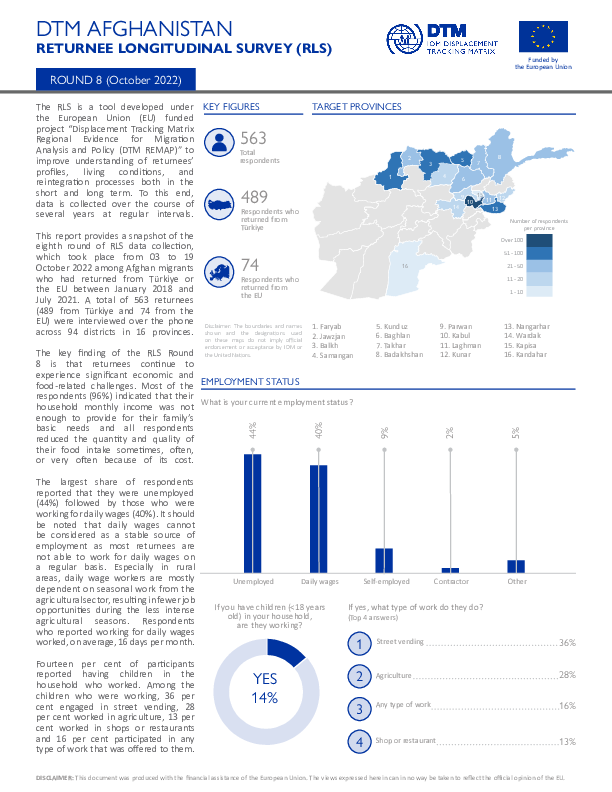
Contact
DTM Afghanistan, DTMAfghanistan@iom.int
Language
English
Location
Afghanistan
Period Covered
Oct 03 2022
Oct 19 2022
Activity
- Survey
To better understand the demographic profiles, living conditions and reintegration processes of Afghan returnees, IOM, under the EU-funded project “Displacement Tracking Matrix Regional Evidence for Migration Analysis and Policy (DTM REMAP)”, developed the Returnee Longitudinal Survey (RLS).
This report provides a snapshot of the eighth round of RLS data collection, which took place from 03 October to 19 October 2022 among Afghan migrants who had returned from Türkiye or the EU between January 2018 and July 2021. A total of 563 returnees (489 from Türkiye and 74 from the EU) were interviewed over the phone across 94 districts in 16 provinces.
